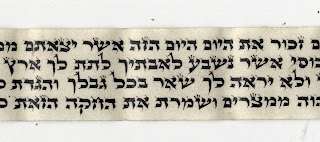Yerios in a Megillah
Shulchan Aruch Y"D 271 and Keset Hasofer (13:3) say that a yeriah in a sefer torah must have a minimum of 3 columns. Does this apply to megillos as well? I would think that it doesn't because we do not keep the other minhagim about the dimensions of yerios in a Sefer Torah i.e. 42 lines and the (much denounced in earlier sefarim) vavei ha'amudim. Furthermore, in the 11 line GR"A megillos I've seen, the maximum of eight columns is also ignored. That being said, does anyone have any further sources or psakim on the issue? It would help me to sew a single amud cut from another piece of parchment into the rest of a megillas Esther, but I'm reluctant to do it because I have never seen a precedent. Hope everyone has a good Civil New Year if it affects any of you who are fulltime klei kodesh anyway :)




.JPG)





